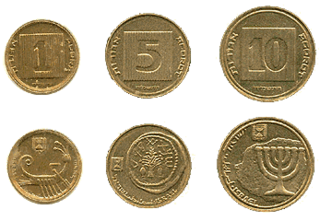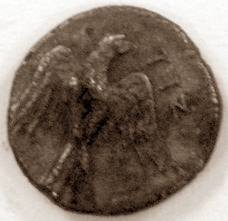 W
WThe 10 agorot controversy refers to a conspiracy theory promoted by Palestine Liberation Organization chairman Yasser Arafat's appearance at a specially convened session of the UN Security Council in Geneva on 25 May 1990. At the session Arafat claimed that the obverse design of an Israeli ten agorot coin showed a map of "Greater Israel" that represented Zionist expansionist goals.
 W
WThe agora is a denomination of the currency of Israel. The Israeli currency – the new Israeli shekel (ILS) or (NIS)– is divided into 100 agorot.
 W
WBar Kokhba Revolt coinage were coins issued by the Judaean rebel state, headed by Simon Bar Kokhba, during the Bar Kokhba revolt against the Roman Empire of 132-135 CE.
 W
WFirst Jewish Revolt coinage was issued by the Jews after the Zealots captured Jerusalem and the Jewish Temple from the Romans in 66 CE at the beginning of the First Jewish Revolt. The Jewish leaders of the revolt minted their own coins to emphasize their newly obtained independence from Rome.
 W
WThe Palestine pound (Arabic: جُنَيْه فِلَسْطَينِيّ, junayh filastini; Hebrew: (פוּנְט פַּלֶשְׂתִינָאִי (א״י, funt palestina'i , also (לירה was the currency of the British Mandate of Palestine from 1 November 1927 to 14 May 1948, and of the State of Israel between 15 May 1948, and 23 June 1952, when it was replaced with the Israeli lira or pound. The Palestine pound was also the currency of Transjordan until 1949 when it was replaced by the Jordanian dinar, and remained in usage in the West Bank of Jordan until 1950. In the Gaza Strip, the Palestine pound continued to circulate until April 1951, when it was replaced by the Egyptian pound.
 W
WThe Israeli pound or Israeli lira was the currency of the State of Israel from 9 June 1952 until 23 February 1980. Its symbol was "I£". The Israeli pound replaced the Palestine pound and was also pegged to the pound sterling at par. It was replaced by the shekel on 24 February 1980, at the rate of 1 shekel = 10 Israeli pounds, which was in turn replaced by the new shekel in 1985.
 W
WPruta was a denomination of currency in Israel prior to 1960.
 W
WPrutah is a Hebrew term, possibly derived from Aramaic. It refers to a small denomination coin.
 W
WShekel or sheqel is an ancient Near Eastern coin, usually of silver. A shekel was first a unit of weight—very roughly 11 grams (0.39 oz)—and became currency in ancient Tyre and ancient Carthage and then in ancient Israel under the Maccabees.
 W
WThe Israeli new shekel, also known as simply the Israeli shekel, is the currency of Israel and is also used as a legal tender in the Palestinian territories of the West Bank and the Gaza Strip. The new shekel is divided into 100 agorot. The new shekel has been in use since 1 January 1986, when it replaced the hyperinflated old shekel at a ratio of 1000:1.
 W
WThe old Israeli shekel, then known as the shekel was the currency of the State of Israel between 24 February 1980 and 31 December 1985. It was replaced by the Israeli new shekel at a ratio of 1000:1 on 1 January 1986. The old shekel was short-lived due to its hyperinflation. The old shekel was subdivided into 100 new agorot. The shekel sign was although it was more commonly denominated as S or IS.
 W
WThe Yehud coinage is a series of small silver coins bearing the Aramaic inscription Yehud. They derive their name from the inscription YHD (𐤉𐤄𐤃), "Yehud", the Aramaic name of the Achaemenid Persian province of Yehud; others are inscribed YHDH, the same name in Hebrew.